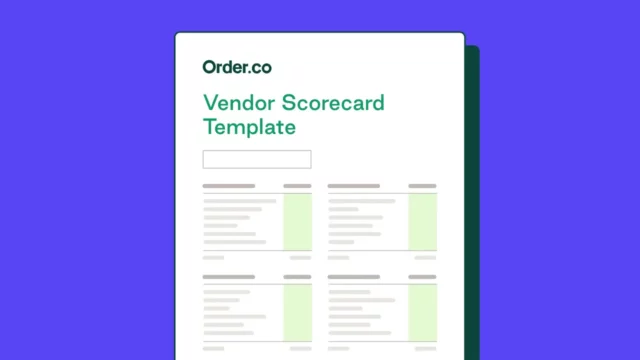Build a Data-Driven Supplier Scorecard With These Tips

Build a Data-Driven Supplier Scorecard With These Tips
You may love working with a certain supplier—most buyers have their favorites. But is your view of their performance more than a feeling? If you want to know how beneficial each relationship is to your business, you need a way to measure them.
Building a data-informed scorecard system is the best way to evaluate every supplier against a consistent standard. An objective scorecard reveals whether your perception of vendor performance lines up with the facts.
To help you create a simple, well-crafted scorecard system, we’ve pulled together this quick guide of actionable steps and scorecard metrics you can use to create tailored insights into your suppliers. By following this approach, you can foster better relationships with vendors and improve outcomes for your purchasing activities.
Download the free tool: Vendor Scorecard Template
Data-driven supplier scorecards: What are the benefits?
Here are some of the most valuable advantages you gain when you take a quantitative approach to evaluating your vendors:
- Increased transparency: Scoring gives you clear insights into supplier performance and its effect on procurement.
- Improved decision-making: Using data-informed reviews helps you make informed decisions about ongoing partnerships.
- Enhanced supplier performance: Highlighting strengths and opportunities helps suppliers improve their offerings.
- Stronger relationships: Providing feedback creates opportunities to build long-term partnerships.
- Better risk management: Standardizing scorecards helps you identify and avoid potential risks. Since over 35% of data breaches come from vendor vulnerabilities, this should be a priority for your review.
How to create a data-driven supplier scorecard
Ready to build a new vendor scorecard program or improve your current system? Here are the steps to take to get the most out of your data.
1. Get clear on your goals
Before you start looking at supplier performance, get together with stakeholders to find out what’s working and what could improve. Use feedback from buyers, department heads, procurement team members, and executives to craft business objectives aligned with your scoring program.
Your team might prioritize:
- Boosting supplier performance in a certain area, like delivery or damages
- Building supply chain reliability and efficiency with your best supply partners
- Cutting costs by partnering with a shortlist of high-quality suppliers
- Reducing risk with a review of supplier safety and resilience
- Strengthening contract compliance in your supplier pool
Once you clarify your goals, you can focus on the best data and KPIs to start your performance evaluation.
2. Collect supplier performance data
Pull in performance data from all supply transactions since your last review. The goal is to create as accurate a picture as possible for each supplier.
If your supplier data doesn't already live in a centralized platform, here are some places to begin your search:
- Purchase orders: Look at past purchase orders and spend reports to get an idea of your supplier’s historical performance.
- Corporate card transactions: Check credit card statements and expense reports for out-of-policy purchases (since lots of purchases still happen on corporate cards, even if your buying policy says they shouldn't).
- Delivery logs: Examine metrics like delivery times, accuracy, and damages to understand how well a supplier is actually serving you.
- Previous scorecards: Review scores from any scoring systems you've used previously to see how performance is changing over time.
- Industry benchmarks: Compare supplier performance to the rest of your pool and broader industry standards to see how it stacks up.
- Risk assessments: Check for breaches or security issues to evaluate how your supplier handles data safety.
3. Track the right key performance indicators
Use KPIs to help you take the temperature of your procurement efforts. When you break KPIs out by vendor, you get clear evidence of performance for each supplier in your supply chain.
Align your KPI choices with the outcomes you’re looking to achieve. Consider your most high-value categories to keep tabs on performance over time, such as:
- Delivery performance
- Order accuracy
- Customer service
- Product quality
- Customer satisfaction
- Pricing
This list should give you a starting point for building a scorecard that reflects your expectations. Each category can include multiple specific metrics to track performance in the most important areas.
4. Use real-time data
Judging performance based on outdated information doesn’t help you improve procurement outcomes. When building a scorecard, use real-time data and supplier information management tools to get a clear look at how vendors are performing against past reviews and industry standards.
Order.co offers visibility into your vendor and order data so you can see how each supplier stacks up. You'll understand where each vendor fits into your procurement process in terms of pricing, contract compliance, service level agreements, and customer satisfaction. Fresh data helps you catch performance issues early so you can get ahead of them.
5. Refine and improve your scoring program
Once your scoring rubric is up and running, look for ways to boost its effectiveness for even better insights. After all, setting up a supplier scorecard is just the beginning of better relationship management.
- Adjust metrics as needed: Goals change, and your metrics should change with them. Review your vendor scorecard process at least yearly and update the metrics to reflect new objectives. These changes can also help you vet suppliers and inform your supplier onboarding process.
- Update your benchmarks: Don’t make new decisions based on outdated info. Use current, credible data sources to update benchmarks according to broader procurement challenges and market trends. Compare supplier performance against these standards to see how they measure up.
- Adapt to outside changes: External forces like market shifts, technology advances, and changing business goals call for adjustments. Your approach to vendor management should be just as dynamic. Use what you learn from each review cycle to refine your process and adjust the criteria.
- Let software help: If you have dozens or hundreds of suppliers, keeping up with scoring can get hectic. Use software to help you understand how vendors are doing. Order.co offers a suite of reports and dashboards that shine a light on spending by category, vendor, location, and more.
How often should you do supplier scorecard reviews?
When it comes to review frequency, the most realistic answer is “it depends.” Mainly, you want to keep a closer eye on your most important vendors. For instance, if you do a lot of business with a single supplier (or if they partner with you on big-ticket purchases), it’s worth reviewing that relationship more often.
As a general rule, plan to score all your vendors at least once a year. For your most valuable partnerships, you may choose to review them semi-annually or even quarterly to make sure everything's on track.
Gain clarity on priorities with a segmentation matrix
Supplier segmentation is a great way to look at how important each vendor is to your business. A Kraljic matrix can help you weigh which suppliers warrant extra attention. This decision-making tool lets you segment your vendors into one of four categories:
- Leverage items: These items aren’t mission-critical, but they can impact the bottom line. You may find opportunities to negotiate with the vendors for these items for better pricing.
- Strategic items: These products are important to your business and can be hard to get. Build partnerships with a few trusted vendors in this category to be sure you can access the supplies you need on time and on budget.
- Routine items: Non-critical items with a low supply risk don’t require as much oversight, so you can review these items at least yearly to ensure consistent costs.
- Bottleneck items: While these products aren’t critical like strategic items, they’re just as important to smooth operations. Be sure to have a backup plan, like a secondary supplier, to reduce the risk of delays or shortages.
Key performance metrics for an effective supplier scorecard
KPIs are the best way to bring fairness and objectivity to your review process. Use metrics to measure a supplier's financial stability, innovation capacity, sustainability efforts, and risk profile. Outline the North Star factors most important to your buying experience and use those as your key metrics.
It’s important to measure fundamental procurement KPIs like these when reviewing your vendors:
Cost
- Average per-unit cost
- Total order value
- Discount percentages and terms
- Year-over-year cost savings
- Price variance
- Price compared to benchmarks
- Percentage of spend by vendor
- Cost impact of disruptions
Product quality
- Defect rate per delivery
- Product quality consistency
- Return and replacement rate
- Warranty claim frequency
- Product lifecycle duration
- Customer satisfaction rating
Service, sustainability, and risk
- On-time delivery rate
- Order accuracy rate
- Inquiry response timeliness
- Issue resolution speed
- Delivery lead times
- Sustainability rating
- Third-party risk profile
Numbers paint a picture, but feedback is equally valuable. Build a scorecard that looks at quantitative measures like defect rates and qualitative aspects of the relationship (like communication and issue resolution).
What to do if your suppliers are underperforming
Every supplier relationship has rough patches. When performance metrics start to slip, corrective action can bring things into alignment.
Clarify the issue: Look at the current outcomes and trace them back to the upstream events. For instance, if there are issues with contract compliance, review the contract itself. Are the terms and conditions straightforward? Are the expectations clear? Sometimes a little clarity is enough to get things back on track.
Open communication: If a once-reliable supplier isn’t living up to their past performance, check in. Schedule a talk with your point of contact to discuss the issue and get their perspective. Good communication can iron out most problems when both parties want to make improvements.
Increase your oversight: When issues arise, put some checks in place to monitor the weak areas of the relationship. For instance, if on-time delivery is a problem, flag the account for a quick check-in with your supplier contact each time you place an order. A timely reminder can prompt action and help prevent further problems.
Move on: No one wants to step away from a partnership prematurely, but if a supplier continues to have issues, it may be time to look elsewhere. Just be sure you’re not costing yourself more by changing than you’ll absorb by staying. Look at your cost of change (which may be 10% or more with technology, tooling, risk, or disruptions) and decide whether it’s worth the move.
Boost business impact with your supplier scorecard
Now that you’ve built a scorecard that reflects your business needs and values, you’ll have greater visibility to make better decisions and manage your vendor relationships more effectively.
Order.co makes it easier to work with vendors that meet your performance expectations and deliver value at the right price. The platform offers a range of features that support ongoing supplier evaluation and relationship-building so you can turn scorecard results into cost savings and greater spend efficiency:
- Access to over 15,000 high-quality vendors for every business need
- Curated catalogs to help your buyers choose products from your preferred suppliers
- Spend analysis and reporting to track how every vendor performs against your scorecard metrics
- Invoice and payment processing features to make sure your top vendors get paid on time
Let Order.co help you build a more efficient, data-driven procurement process that helps you maintain strong supplier partnerships and continuously improve purchasing outcomes. Get a demo to learn more.
Get started
Schedule a demo to see how Order.co can simplify buying for your business.
"*" indicates required fields



